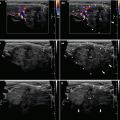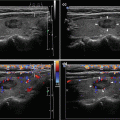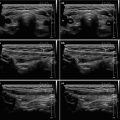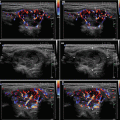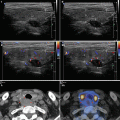and Zdeněk Fryšák1
(1)
Department of Internal Medicine III – Nephrology, Rheumatology and Endocrinology, Faculty of Medicine and Dentistry, Palacky University Olomouc and University Hospital Olomouc, Olomouc, Czech Republic
Keywords
Medullary thyroid carcinomaSerum calcitoninCalcificationsLymph node metastases16.1 Essential Facts
Medullary thyroid carcinoma (MTC) constitutes approximately 2–5% of all thyroid malignancies, but it is responsible for up to 13.4% of all deaths from thyroid cancer. The prevalence is about the same in both males and females [1].
It is a well-differentiated type of tumor that arises from the parafollicular (C cells) of the thyroid gland, and is categorized as a neuroendocrine tumor [1].
The parafollicular cells secrete calcitonin. Serum calcitonin is greatly elevated in almost all patients with MTC. There appears to be a direct correlation of calcitonin level and the extent of thyroid involvement by MTC.
In 80% of patients MTC occurs sporadically, as a result of a mutation involving only the somatic cells. Sporadic forms of MTC are more common in older patients (mean age at presentation about 47 years) [1].
About 20% of patients have familial MTC, caused by germline mutation in the RET protooncogene. The hereditary forms of MTC are more common in younger patients.
MTC is considered to be less aggressive than ATC, but more lethal than PTC and FTC.
While most patients with MTC typically present with a palpable nodule in the upper part of the thyroid lobe, some patients may present with systemic symptoms associated with distant metastases [1].
The clinical course of both forms of MTC is described in retrospective review of 104 patients by Kebebew; 56% of patients had sporadic MTC, 22% had familial MTC, 15% had MEN 2A, and 7% had MEN 2B [2]:
32% of the patients with hereditary MTC were diagnosed by screening (genetic and/or biochemical). These patients had a lower incidence of cervical lymph node metastasis and 94.7% were cured at last follow-up compared with patients not screened.
Patients with sporadic MTC who had systemic symptoms (diarrhea, bone pain, or flushing) had widely metastatic MTC and 33.3% of those patients died within 5 years.
Overall, 49.4% of the patients were cured. In addition, 12.3% had recurrent MTC and 38.3% had persistent MTC. Patients with persistent or recurrent MTC who died of MTC lived for an average of 3.6 years.
Screening for MTC and early treatment (total thyroidectomy with central neck lymph node clearance) had a nearly 100% cure rate.
16.2 US Features of Medullary Thyroid Carcinoma
Moreover, it is emphasized [5]:


Fig. 16.1
(aa) A 39-year-old woman with a solitary small medullary thyroid carcinoma—MTC (arrowheads) in the RL, size 22 × 16 × 12 mm and volume 2 mL, without metastatic cervical lymph nodes. Laboratory: serum calcitonin 1248 ng/L (normal < 11.5 ng/L). US overall view: solid nodule; round shape; inhomogeneous structure; mixed echogenicity, central isoechoic, periphery hypoechoic; well-defined margin; irregular thin halo sign; Tvol 13 mL, RL 8 mL, and LL 5 mL; transverse. (bb) Detail of small MTC (arrowheads): round shape; mixed echogenicity; well-defined margin; transverse. (cc) Detail of small MTC (arrowheads), CFDS: minimal peripheral and central vascularity, pattern I; transverse. (dd) Detail of small MTC (arrowheads): ovoid shape; inhomogeneous structure; mostly isoechoic; three microcalcifications at periphery (arrows); well-defined margin; irregular thin halo sign; longitudinal. (ee) Detail of small MTC (arrowheads), CFDS: minimal peripheral and central vascularity, pattern I; longitudinal
Stay updated, free articles. Join our Telegram channel

Full access? Get Clinical Tree



